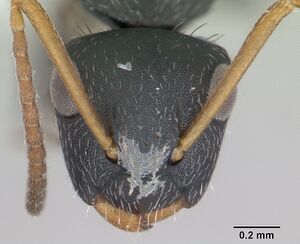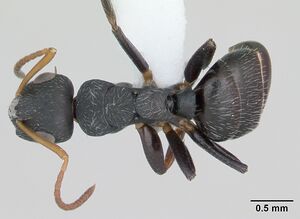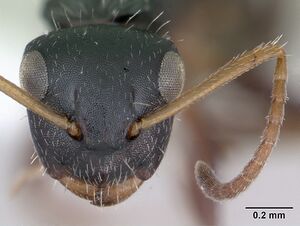Camponotus sanctaefidei
| Camponotus sanctaefidei | |
|---|---|

| |
| Scientific classification | |
| Kingdom: | Animalia |
| Phylum: | Arthropoda |
| Class: | Insecta |
| Order: | Hymenoptera |
| Family: | Formicidae |
| Subfamily: | Formicinae |
| Tribe: | Camponotini |
| Genus: | Camponotus |
| Species: | C. sanctaefidei |
| Binomial name | |
| Camponotus sanctaefidei Dalla Torre, 1892 | |
| Subspecies | |
| |
| Synonyms | |
Specimens have been collected from dead twigs.
Identification
Distribution
Latitudinal Distribution Pattern
Latitudinal Range: 18.7722° to -22.809943°.
| North Temperate |
North Subtropical |
Tropical | South Subtropical |
South Temperate |
- Source: AntMaps
Distribution based on Regional Taxon Lists
Neotropical Region: Argentina, Bolivia, Brazil, Colombia (type locality), Costa Rica, Guatemala, Honduras, Mexico, Panama, Paraguay, Peru.
Distribution based on AntMaps
Distribution based on AntWeb specimens
Check data from AntWeb
Countries Occupied
| Number of countries occupied by this species based on AntWiki Regional Taxon Lists. In general, fewer countries occupied indicates a narrower range, while more countries indicates a more widespread species. |

|
Estimated Abundance
| Relative abundance based on number of AntMaps records per species (this species within the purple bar). Fewer records (to the left) indicates a less abundant/encountered species while more records (to the right) indicates more abundant/encountered species. |

|
Biology
Flight Period
| X | X | X | X | X | X | X | |||||
| Jan | Feb | Mar | Apr | May | Jun | Jul | Aug | Sep | Oct | Nov | Dec |
Source: Kaspari et al., 2001.
- Check details at Worldwide Ant Nuptial Flights Data, AntNupTracker and AntKeeping.
 Explore: Show all Flight Month data or Search these data. See also a list of all data tables or learn how data is managed.
Explore: Show all Flight Month data or Search these data. See also a list of all data tables or learn how data is managed.
Castes
Wheeler (1934) - My specimens show that the worker is not strongly dimorphic, as Emery seems to have supposed, but trimorphic. There are large and small "soldiers" in the same colony. The smaller ones may be called "mediae," but unlike the members of this subcaste in many other species of Camponotus, they differ much less from the true maximae than from the minimae.
Worker
Images from AntWeb
   
| |
| Worker. Specimen code casent0173447. Photographer April Nobile, uploaded by California Academy of Sciences. | Owned by ALWC, Alex L. Wild Collection. |
   
| |
| Worker (major/soldier). Specimen code casent0173557. Photographer April Nobile, uploaded by California Academy of Sciences. | Owned by JTLC, John T. Longino Collection. |
   
| |
| Worker. Specimen code inbiocri002280732. Photographer April Nobile, uploaded by California Academy of Sciences. | Owned by JTLC. |
Queen
Images from AntWeb
   
| |
| Queen (alate/dealate). Specimen code casent0173446. Photographer April Nobile, uploaded by California Academy of Sciences. | Owned by ALWC, Alex L. Wild Collection. |
Nomenclature
The following information is derived from Barry Bolton's Online Catalogue of the Ants of the World.
- quadrilaterus. Camponotus quadrilaterus Mayr, 1887: 519 (w.) COLOMBIA.
- Type-material: holotype minor worker.
- Type-locality: Colombia: Santa Fe de Bogota (no collector’s name).
- Type-depository: NHMW.
- Emery, 1894c: 171 (s.q.).
- [Junior primary homonym of Camponotus quadrilaterus Roger, 1863a: 136.]
- Status as species: Dalla Torre, 1893: 249; Emery, 1894c: 171; Forel, 1895b: 141; Emery, 1896d: 377 (in list).
- Replacement name: Camponotus sanctaefidei Dalla Torre, 1892: 92.
- sanctaefidei. Camponotus sanctaefidei Dalla Torre, 1892: 92.
- Replacement name for Camponotus quadrilaterus Mayr, 1887: 519. [Junior primary homonym of Camponotus quadrilaterus Roger, 1863a: 136.]
- Wheeler, W.M. 1934e: 228 (s.w.q.).
- Combination in C. (Myrmocladoecus): Emery, 1925b: 167.
- Status as species: Forel, 1899c: 145; Emery, 1925b: 167; Menozzi, 1927c: 268; Wheeler, W.M. 1934g: 227 (redescription); Kempf, 1970b: 342; Kempf, 1972a: 56; Brandão, 1991: 333; Bolton, 1995b: 122; Wild, 2007b: 28; Branstetter & Sáenz, 2012: 256; Bezděčková, et al. 2015: 113; Mackay & Mackay, 2019: 767.
- Distribution: Bolivia, Brazil, Colombia, Costa Rica, Guatemala, Mexico, Panama, Paraguay, Peru.
- Current subspecies: nominal plus convexinodis, coronatus, hondurianus, leonhardi, weberi.
Unless otherwise noted the text for the remainder of this section is reported from the publication that includes the original description.
Description
Wheeler (1934) - minima Length 3-3.5 mm.
Head trapezoidal, as broad or very nearly as broad as long, with distinctly convex posterior border and straight, anteriorly converging sides and carinae extending from the posterior orbits of the convex, posteriorly situated eyes to the occipital border. Mandibles thinner and with much less convex external borders than in the maxima and media, teeth 6 to 7, small, rather crowded. Clypeus of the usual structure, without protuberances, broader than long, convex and carinate in the middle, the anterior border broadly rounded and somewhat projecting. Antennal scapes extending nearly half their length beyond the posterior border of the head. Thorax more flattened above than in the maxima and media; pronotum twice as broad as long with distinct indications of humeral angles; posterior corners of the base of the epinotum developed as flattened, slightly upturned lobe-like teeth, separated by an arcuate, marginate excision; declivity strongly concave. Petiole in profile with the short anterior surface concave and forming a sharp angle with the dorsal surface which is straight or even slightly concave; its sides from above distinctly concave; superior border broad, rather acute, crenulate, produced on each side below as a distinct tooth. Gaster oval, proportionally shorter than in the maxima and media.
Head, and especially the thorax, more sharply and coarsely punctate, the petiole transversely striolate. Pilosity longer and more abundant, pubescence very distinct on the anterior portion of the head and dorsal surface of the thorax and gaster. Black; gaster often paler brown than in the media and maxima; mandibles, anterior border of clypeus and cheeks, antennae and legs, brownish yellow; tips of funiculi and femora darker brown; flexor surfaces of tibiae sometimes brownish.
Wheeler (1934) - media Length 4-4.5 mm.
Differing from the maxima in its distinctly smaller stature and smaller and somewhat shorter head, which has slightly more rounded anterior and posterior corners, slightly less developed protuberances on the posterior half of the clypeus, somewhat more convex eyes, slightly longer antennal scapes, more pronounced and more flattened, lobe-like and longer teeth on the base of the epinotum. The angle between the anterior and dorsal surfaces of the petiole is sharper, so that the scale has the three surfaces even more distinct than the maxima. Seen from above the petiole is trapezoidal, with straight, anteriorly converging sides and the oblique or dorsal surface transversely convex.
Sculpture, pilosity and color as in the maxima.
maxima Length 4.5-5 mm.
Head suboblong, convex above, one and one-fourth times as long as broad, with somewhat convex posterior border, rectangular anterior and posterior corners and straight, parallel sides, slightly sinuate at the cheeks. Eyes moderately large, flat, distant about their greatest diameter from the posterior corners of the head. Mandibles somewhat flattened above, with very convex external borders, 6-toothed, the three basal teeth short. Clypeus subrectangular, somewhat longer than broad, concave anteriorly, with broadly excised and bluntly bidentate median border; on the posterior half with two large, anteriorly diverging protuberances, which in profile give the clypeus a truncated appearance since each protuberance forms a projecting angle, with its upper or posterior border horizontal and feebly convex, its anterior border concave and perpendicular. Frontal area distinct, trapezoidal; frontal carinae anteriorly approximated, sinuous, diverging behind; frontal groove very distinct. Antennae rather slender; scapes curved, their tips extending only a distance equal to their greatest diameter beyond the posterior border of the head. Thorax stout, much narrower than the head, but nearly of the same length, including the mandibles, somewhat flattened above and laterally, with sharp promesonotal and mesoepinotal sutures, and a distinct but not very deep impression at the latter. Pronotum less than twice as broad as long, semicircularly rounded in front, laterally marginate, but without humeral angles; mesonotum transversely elliptical, nearly half again as broad as long; metathoracic spiracles large and prominent; epinotum with feebly convex base, slightly longer than broad, rounded anteriorly, with marginate, parallel sides and the posterior border transverse and distinctly excised in the middle, the posterior corners projecting as short, blunt teeth, the declivity perpendicular, concave, as long as the base. Petiolar scale broader than the epinotum, thick, with rounded superior border and ventrally converging sides, the posterior surface fiat, the anterior really consisting of two surfaces meeting at an obtuse angle, the more ventral surface perpendicular, the dorsal sloping upward and backward to the superior border. Gaster elongate-elliptical, parallel-sided in the middle, the first segment anteriorly truncated, with an impression for the accommodation of the petiolar scale. Legs stout, fore femora somewhat incrassated, tibiae clavate, not compressed.
Head, thorax and appendages subopaque, petiole and gaster shining; mandibles rather smooth, sparsely punctate; head and petiole very finely and indistinctly punctulate; thorax, especially on the sides, more coarsely reticulate, or evenly and densely punctate; clypeus and cheeks with shallow punctures; front, especially along the carinae, vertex and thoracic dorsum with large, scattered piligerous punctures, or foveolae. Gaster very finely shagreened, almost transversely striolate, with sparse, oblique, piligerous punctures.
Hairs sordid white or brownish on the thorax, white on the head and gaster, only moderately long, erect, sparse and rather blunt; short and subappressed on the appendages; pubescence whitish, appressed, short and dilute; almost lacking on the head and thorax, distinct on the gaster.
Black; gaster often very dark brown, with narrow, yellowish margins to the segments; clypeus and cheeks dull red; coxae, femora and often also the apices of the tibiae, brown; mandibles, except the teeth, antennae, neck, tips of coxae, trochanters, tarsi and bases of tibiae brownish yellow; terminal funicular joints infuscated.
Queen
Wheeler (1934) - Length 6 mm.
Head shaped as in the worker maxima but with less pronounced anterior and posterior corners and larger and more convex eyes. The mandibles and clypeus are also very similar, but the paired protuberances on the latter are less developed and more like those of the media. Antennal scapes extending twice their greatest diameter beyond the posterior border of the head. Thorax short, about twice as long as wide; mesonotum slightly flattened, as broad as long; epinotum short, its base convex, sloping backward and forming a distinct angle with the longer, perpendicular and only slightly concave declivity. Petiole shaped as in the maxima but somewhat thicker. Gaster large, elongate- elliptical, as long as the remainder of the body. Wings measuring 6mm.
Shining; head subopaque, very finely and indistinctly punctulate as in the maxima, with somewhat more shining, punctate mandibles; clypeus and cheeks with small, front with large punctures as in that phase.
Pilosity as in the maxima; pubescence very short, dilute, visible only on the gaster.
Black; mandibles, clypeus and cheeks deep red; palpi and antenna: yellow, the funiculi infuscated distally. Femora dark brown; tibiae and tarsi paler, more reddish brown. Wings clear, iridescent, with pale brown veins and pterostigma.
References
- Albuquerque, E., Prado, L., Andrade-Silva, J., Siqueira, E., Sampaio, K., Alves, D., Brandão, C., Andrade, P., Feitosa, R., Koch, E., Delabie, J., Fernandes, I., Baccaro, F., Souza, J., Almeida, R., Silva, R. 2021. Ants of the State of Pará, Brazil: a historical and comprehensive dataset of a key biodiversity hotspot in the Amazon Basin. Zootaxa 5001, 1–83 (doi:10.11646/zootaxa.5001.1.1).
- Dalla Torre, K. W. von. 1892. Hymenopterologische Notizen. Wien. Entomol. Ztg. 11: 89-93 (page 92, Replacement name for quadrilaterus Mayr)
- Emery, C. 1925d. Hymenoptera. Fam. Formicidae. Subfam. Formicinae. Genera Insectorum 183: 1-302 (page 167, Combination in C. (Myrmocladoecus))
- Franco, W., Ladino, N., Delabie, J.H.C., Dejean, A., Orivel, J., Fichaux, M., Groc, S., Leponce, M., Feitosa, R.M. 2019. First checklist of the ants (Hymenoptera: Formicidae) of French Guiana. Zootaxa 4674, 509–543 (doi:10.11646/zootaxa.4674.5.2).
- Kaspari, M., Pickering, J., Longino, J., Windsor, D. 2001. The phenology of a Neotropical ant assemblage: evidence for continuous and overlapping reproduction. Behavioral Ecology and Sociobiology 50, 382–390 (doi:10.1007/s002650100378).
- Mayr, G. 1887. Südamerikanische Formiciden. Verh. K-K. Zool.-Bot. Ges. Wien 37: 511-632 (page 519, [Junior primary homonym of quadrilaterus Roger, 1863a: 136.])
- Perger, R., Rubio, G.D. 2020. Sympolymnia, a new genus of Neotropical ant-like spider, with description of two new species and indirect evidence for transformational mimicry (Araneae, Salticidae, Simonellini). Zoosystematics and Evolution 96, 781–795 (doi:10.3897/zse.96.55210).
- Wheeler, W. M. 1934g. Neotropical ants collected by Dr. Elisabeth Skwarra and others. Bulletin of the Museum of Comparative Zoology 77: 157-240 (page 228, soldier, worker, queen described)
References based on Global Ant Biodiversity Informatics
- Adams B. J., S. A. Schnitzer, and S. P. Yanoviak. 2019. Connectivity explains local ant community structure in a Neotropical forest canopy: a large-scale experimental approach. Ecology 100(6): e02673.
- Benitez-Malvido, J., W. Dattilo, A. P. Martinez-Falcon, C. Duran-Barron, J. Valenzuela, S. Lopez, and R. Lombera. 2016. The multiple impacts of tropical forest fragmentation on arthropod biodiversity and on their patterns of interactions with host plants. Plos One 11: e0146461.
- Bezdeckova K., P. Bedecka, and I. Machar. 2015. A checklist of the ants (Hymenoptera: Formicidae) of Peru. Zootaxa 4020 (1): 101–133.
- Boer P. 2019. Ants of Curacao, species list. Accessed on January 22 2019 at http://www.nlmieren.nl/websitepages/SPECIES%20LIST%20CURACAO.html
- Brandao, C.R.F. 1991. Adendos ao catalogo abreviado das formigas da regiao neotropical (Hymenoptera: Formicidae). Rev. Bras. Entomol. 35: 319-412.
- Castano-Meneses, G., M. Vasquez-Bolanos, J. L. Navarrete-Heredia, G. A. Quiroz-Rocha, and I. Alcala-Martinez. 2015. Avances de Formicidae de Mexico. Universidad Nacional Autonoma de Mexico.
- Dattilo W. et al. 2019. MEXICO ANTS: incidence and abundance along the Nearctic-Neotropical interface. Ecology https://doi.org/10.1002/ecy.2944
- De la Mora A., C. J. Murnen, and S. M. Philpott. 2013. Local and landscape drivers of biodiversity of four groups of ants in coffee landscapes. Biodiv. Conserv. 22: 871-888.
- Emery C. 1894. Studi sulle formiche della fauna neotropica. VI-XVI. Bullettino della Società Entomologica Italiana 26: 137-241.
- Fernández, F. and S. Sendoya. 2004. Lista de las hormigas neotropicales. Biota Colombiana Volume 5, Number 1.
- Franco W., N. Ladino, J. H. C. Delabie, A. Dejean, J. Orivel, M. Fichaux, S. Groc, M. Leponce, and R. M. Feitosa. 2019. First checklist of the ants (Hymenoptera: Formicidae) of French Guiana. Zootaxa 4674(5): 509-543.
- INBio Collection (via Gbif)
- Kempf, W.W. 1972. Catalago abreviado das formigas da regiao Neotropical (Hym. Formicidae) Studia Entomologica 15(1-4).
- Longino J. T. 2013. Ants of Honduras. Consulted on 18 Jan 2013. https://sites.google.com/site/longinollama/reports/ants-of-honduras
- Longino J. T. 2013. Ants of Nicargua. Consulted on 18 Jan 2013. https://sites.google.com/site/longinollama/reports/ants-of-nicaragua
- Longino J. T., J. Coddington, and R. K. Colwell. 2002. The ant fauna of a tropical rain forest: estimating species richness three different ways. Ecology 83: 689-702.
- Longino J. et al. ADMAC project. Accessed on March 24th 2017 at https://sites.google.com/site/admacsite/
- Longino, J.T. 2010. Personal Communication. Longino Collection Database
- Menozzi C. 1927. Formiche raccolte dal Sig. H. Schmidt nei dintorni di San José di Costa Rica. Entomologische Mitteilungen. Berlin-Dahlem. 16: 266-277.
- Mirmecofauna de la reserva ecologica de San Felipe Bacalar
- Ottonetti L., L. Tucci, F. Frizzi, G. Chelazzi, and G. Santini. 2010. Changes in ground-foraging ant assemblages along a disturbance gradient in a tropical agricultural landscape. Ethology Ecology & Evolution 22: 7386.
- Smith M. A., W. Hallwachs, D. H. Janzen. 2014. Diversity and phylogenetic community structure of ants along a Costa Rican elevational gradient. Ecography 37(8): 720-731.
- Wheeler W. M. 1934. Neotropical ants collected by Dr. Elisabeth Skwarra and others. Bulletin of the Museum of Comparative Zoology 77: 157-240.
- Wild, A. L.. "A catalogue of the ants of Paraguay (Hymenoptera: Formicidae)." Zootaxa 1622 (2007): 1-55.
- Wilson E. O. 1962. Behavior of Daceton armigerum (Latreille), with a classification of self-grooming movements in ants. Bulletin of the Museum of Comparative Zoology 127: 403-421.
- Wilson, E.O. 1987. The Arboreal Ant Fauna of Peruvian Amazon Forests: A First Assessment. Biotropica 19(3):245-251.

